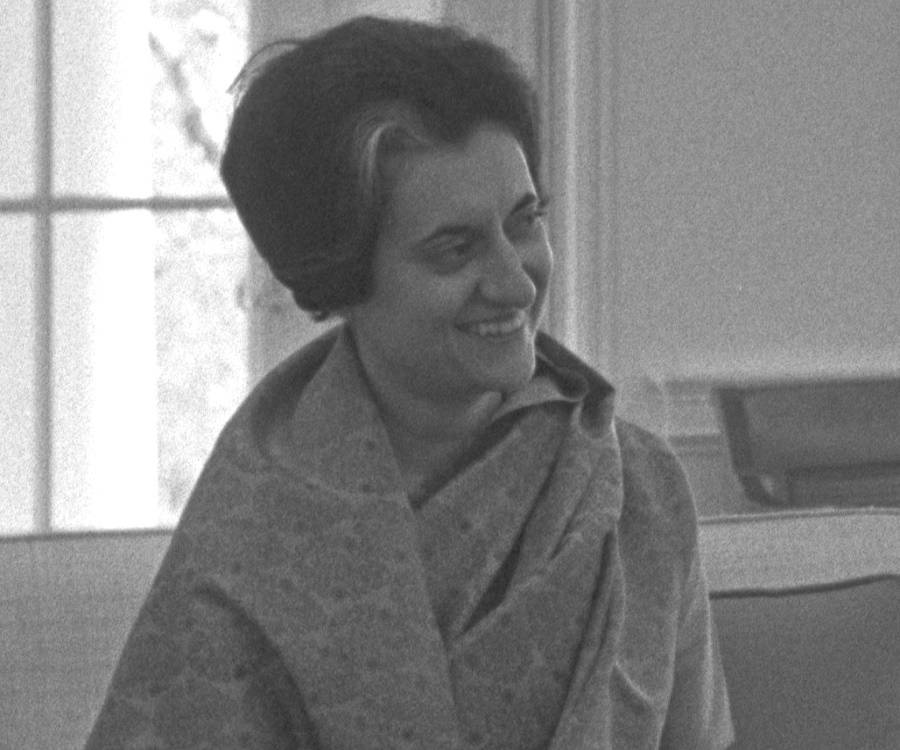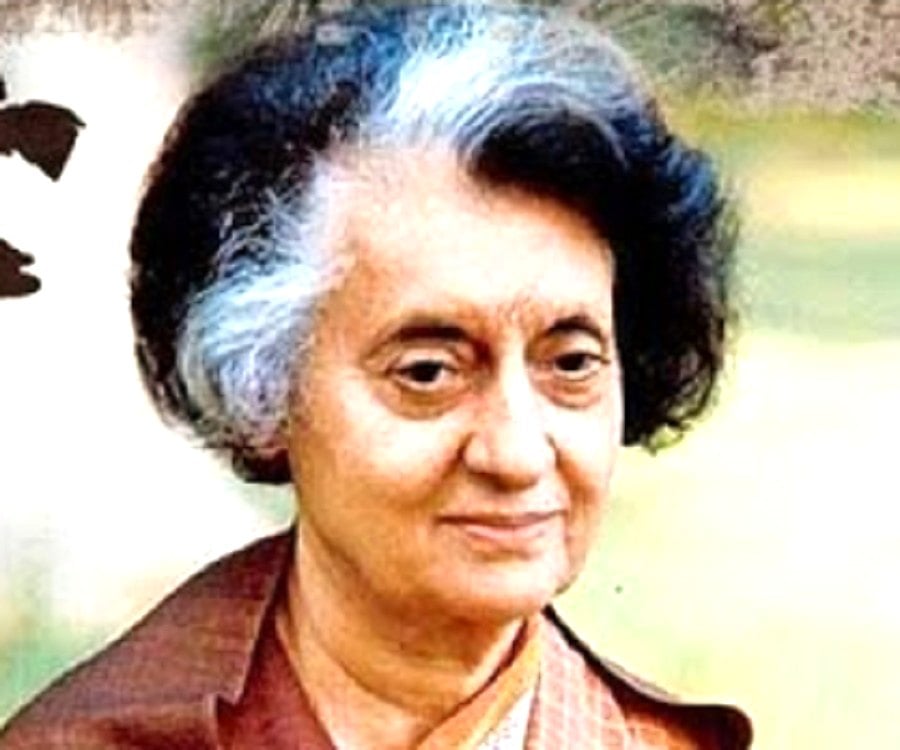Indira Gandhi
| Famous as | Former Prime Minister of India |
| Born on | 19 November 1917 |
| Born in | Allahabad, Uttar Pradesh |
| Died on | 31 October 1984 |
| Nationality | India |
| Works & Achievements | First Woman Prime Minister of India; Lenin Peace Prize (for 1983-1984) |
Childhood
Indira Gandhi was born in an aristocratic family of Nehru on 19
November, 1917, in Allahabad. Her father, Jawaharlal Nehru was a lawyer
and also leader of the Indian Nationalist Movement. Indira's mother,
Kamala, was a religious lady. It was reported that there was a huge
difference between the lifestyle of Jawaharlal Nehru and his wife
Kamala. The Nehrus, for traditions, followed a more-western and
sophisticated lifestyle. This is one of the reasons her mother had nearly-isolated herself from the values of the Nehrus.
Indira’s Grandfather, Motilal Nehru was a renowned barrister of that period. He was also a prominent member of the Indian
National Congress Party. Due to this, lot of noted leaders and party
activists would visit the “Nehru House”. Mahatma Gandhi was one of
them. Therefore, since childhood, Indira Gandhi had developed an
interest in the affairs of country’s politics. Indira Gandhi attended
prominent schools including Shantiniketan, Badminton School and Oxford,
but she showed no great aptitude for academics, and was detained from
obtaining a degree. In 1936, her mother, Kamala Nehru, finally succumbed
to tuberculosis after a long struggle. She was eighteen at the time.
Jawaharlal Nehru was languishing in the Indian jails that time.
Marriage Life and Politics
After returning from Oxford University, Indira started
participating enthusiastically in the national movement. In 1941, Indira
married Feroze Gandhi, a journalist and key member of the Youth
Congress. Though Nehru had raised a strong objection to the marriage of
his daughter with a Parsi, but could not prevent Indira. In 1944, Indira
gave birth to Rajiv Gandhi followed two years later by Sanjay Gandhi.
Feroze later became editor of a newspaper of the Indian National
Congress Party in Allahabad. Indira and Feroze were happily settled
there in Allahabad but things worsened after Indira decided to shift to
Delhi, with her father. She moved to Delhi, with two sons, while Feroze
Gandhi stayed back
During the 1951-52 Parliamentary Elections, Feroze Gandhi was asked
to contest election from Rae Bareli. He eventually won the elections
and moved to Delhi, but opted to live in a separate house. Feroze, with
time gained popularity and soon became a prominent face against
corruption. His popularity increased, especially after he exposed a
major financial scandal in the Nehru led cabinet. It was reported that
the then Finance Minister T.T. Krishnamachari, a close aided of Nehru,
was involved in the scandal that would benefit the major insurance
companies. . On 8 September 1960, Feroze died after a major cardiac
arrest.
Indira as Congress President
Indira Gandhi was a devoted partisan of the Congress Party and
became one of the political advisors of Prime Minister Jawaharlal Nehru.
In 1959, she was elected as the President of the Indian National
Congress Party. After Jawaharlal Nehru passed away on 27 May 1964,
Indira Gandhi contested elections and eventually elected. She was
appointed as the Information and Broadcasting Minister during Prime
Minister Lal Bahadur Shastri.
At that time, people in southern parts of India were protesting
over Hindi being considered as the national language. With each day, the
situation was worsening in the region. In order to pacify the anger of
community leaders, Indira Gandhi visited Madras (now Chennai). Indira
Gandhi had a very good manipulating the media and she used them as an
instrument of image-making. During the Indo-Pakistani War of 1965,
Indira Gandhi was on a holiday trip to Srinagar. Despite repeated
warnings by the security forces that Pakistani insurgents had entered
very close to the hotel, she was staying, Gandhi refused to move. The
incident fetched her huge national and international media attention.
As Prime Minister
Following the death of Lal Bahadur Shastri on 11 January 1966, in Tashkent, the party
countered a serious trouble, as, some of the senior leaders of the
Congress party desired to contest. Unable to reach at a consensus, the
high-command led by K Kamaraj picked Indira as their contender. Senior
Congress leader Morarji Desai opposed Indira’s nomination for the
coveted throne and decided to contest against her. During voting, Desai
gained only 169 votes as compared to Indira’s 355 votes. The virtual
reason behind Indira’s selection for the post was the belief that
“Indira is not so competent in taking decisions and thus she would,
indirectly be controlled by the top leadership.” But Indira Gandhi, in
contrast to the high-command, showed extraordinary political skills and
elbowed the Congress stalwarts out of power.
The election of Indira Gandhi increased the differences of opinion
between the top Congress leaders. The split looked evident as the
members hardly looked united on any issue. To dispel the growing chances
of split-up, Indira Gandhi inducted Morarji Desai in the cabinet. He
was appointed as Deputy Prime Minister and then Finance Minister of the
country. In 1969, Gandhi issued order to nationalize all the banks of
the country.
In 1971, to solve the Bangladeshi refugee problem, she declared
war, on Pakistan, on the side of the East Pakistanis, who were fighting
for their independence. The US President Richard Nixon, supporting West
Pakistan sent its Seventh Fleet to the Bay of Bengal as a warning to
India keep away from East Pakistan. This move had further alienated
India from the First World and brought close to the USSR further. To
strengthen the national security, in 1974, India successfully conducted
an underground nuclear test, at Pokhran in Rajasthan.
Declaration of Emergency
During 1975, the Opposition parties joined by local groups and NGOs
staged regular demonstrations in almost all the states of the country
protesting against the rising inflation and unchecked corruption in the
government. The intensity of protest was increasing day by day. The
government failed to pacify them and contain the movement. At the same
time, Allahabad High Court, hearing a petition against Indira Gandhi
ruled that she had used illegal practices during the election. The Court
also ordered her to vacate the seat, immediately. The ruling helped in adding
fuel to the ongoing political fire. The agitation and anger of the
people amplified. Realizing the consequences, Indira Gandhi, on 26 June,
1975, declared “a state of emergency, due to the turbulent political
situation in the country”.
Now, the political baton came into the hands of Indira Gandhi,
which she used very tactfully. All her political rivals were imprisoned,
constitutional rights of the citizens were abrogated, and the press
placed under strict censorship. It was reported that the leaders of the
Opposition parties were beaten and assaulted in the jail.
Taking advantage of the situation, her younger son, Sanjay Gandhi,
began to run the country as a dictator. He ordered the removal of slum
dwellings, and in an attempt to curb India's growing population,
initiated a highly resented program of forced sterilization. In 1977,
Indira Gandhi called for elections. It was reported that the call for an
election was taken after she apprehended a threat of military coup.
Post Emergency Period
In the next elections, Indira Gandhi was completely defeated by the
Janata Dal, led by Morarji Desai and Jai Prakash Narayan. Congress
managed to win only 153 Lok Sabha seats, as compared to 350 seats it
grabbed in the previous Lok Sabha. During the electoral campaign, Janata
Dal leaders urged the people to choose between “democracy and
dictatorship”.
Though the Janata Dal emerged victorious by a huge margin it could
not keep the coalition intact for longer. The allies were concentrated
more on the self-development. They would fight almost on all the issue
and every ally threatened to quit it their interest is not served. The
internal strife became evident within months of taking charge.
To divert the attention of the people from their failure the Janata
Dal ordered to arrest Indira Gandhi. However, the strategy crashed
disastrously and gained Indira Gandhi, a great sympathy. Indira Gandhi
started giving out speeches and highlighted the wrong policies of the
Janata government. In the next elections held in January 1980, Congress
returned to power with a landslide majority. Political experts viewed
the victory of the Congress as a result of inefficient and ineffective
“Janata Dal”.
Operation Blue Star and Her Assassination
Two events of the Indian political history that tarnished the image
of Indira Gandhi were declaration of emergency in 1975 and launching of
Operation Blue Star in Punjab. In September 1981, a Sikh militant group
led by Jarnail Singh Bhindranwale demanded a separate state of
Khalistan. They started motivating people in Punjab and organized
several outfits to carry out their plans.
In June, they entered into the premises of the Golden Temple,
Amritsar to take shelter. Indira Gandhi asked Lieutenant General S.K.
Sinha, then Vice Chief of Indian Army to prepare a position paper for
assault on the Golden Temple. Sinha advised her against any such move
suggested to adopt an alternative solution. But Indira Gandhi sticked to
her idea and on the night of June 5 the Indian Army stormed the Golden
Temple led by Major General Kuldip Singh Brar. The security forces had
managed to kill Bhindranwale along with other separatists but a large
number of followers and innocent civilians were also killed in the
exchange of fire inside the holy shrine.
The act was viewed as an unparalleled tragedy in the Indian
political history. The impact of the onslaught increased the communal
tensions in the country as many Sikhs resigned from the armed and civil
administrative office and also returned their government awards. On 31
October 1984, Indira Gandhi’s bodyguards Satwant Singh and Beant Singh,
as avenge of the Golden Temple assault, assassinated the Prime Minister
at her Safdarjung Road residence.
| ||||
Timeline: | ||||
1917: Indira Gandhi was born in Allahabad, Uttar Pradesh
1936: Her mother died of tuberculosis
1942: Indira Gandhi married Feroze Gandhi.
1944: Rajiv Gandhi was born.
1946: Birth of Sanjay Gandhi.
1960: Feroze Gandhi died.
1966: Indira Gandhi is elected as Prime Minister of India.
1975: Declaration of state of emergency
1975: Sterilization enforced.
1980: Indira Gandhi re-elected as Prime Minister.
1980: Sanjay dies in plane crash.
1984: Golden Temple Massacre.
1984: Indira Gandhi is assassinated.
|










0 comments:
Post a Comment